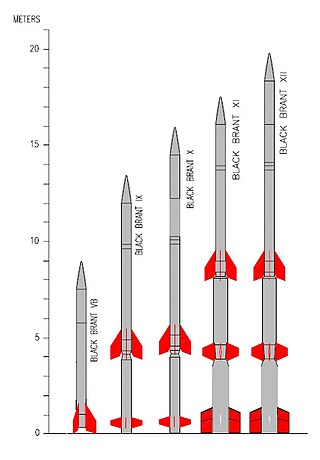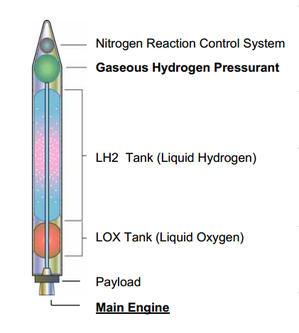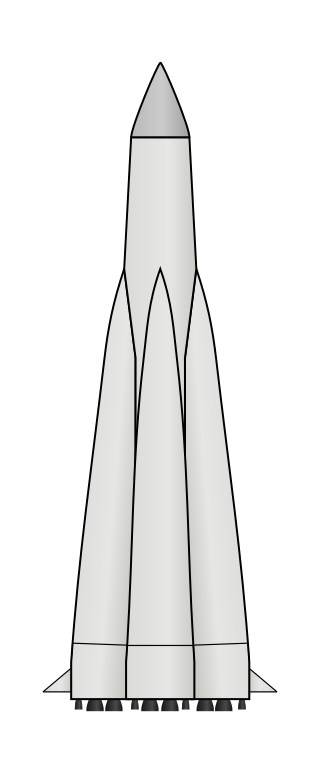
A single-stage-to-orbit (SSTO) vehicle reaches orbit from the surface of a body using only propellants and fluids and without expending tanks, engines, or other major hardware. The term usually, but not exclusively, refers to reusable vehicles. To date, no Earth-launched SSTO launch vehicles have ever been flown; orbital launches from Earth have been performed by either fully or partially expendable multi-stage rockets.

Soyuz is a family of expendable Russian and Soviet carrier rockets developed by OKB-1 and manufactured by Progress Rocket Space Centre in Samara, Russia. With over 2,000 flights since its debut in 1966, the Soyuz is the rocket with the most launches in the history of spaceflight.

The Aerobee rocket was one of the United States' most produced and productive sounding rockets. Developed by the Aerojet Corporation, the Aerobee was designed to combine the altitude and launching capability of the V-2 with the cost effectiveness and mass production of the WAC Corporal. More than 1000 Aerobees were launched between 1947 and 1985, returning vast amounts of astronomical, physical, aeronomical, and biomedical data.
Big Dumb Booster (BDB) is a general class of launch vehicle based on the premise that it is cheaper to operate large rockets of simple design than it is to operate smaller, more complex ones regardless of the lower payload efficiency. As referred to by the Office of Technology Assessment:
The term Big Dumb Booster has been applied to a wide variety of concepts for low-cost launch vehicles, especially those that would use "low technology" approaches to engines and propellant tanks in the booster stage. As used here, it refers to the criterion of designing launch systems for minimum cost by using simplified subsystems where appropriate.

Saturn-Apollo 5 (SA-5) was the first launch of the Block II Saturn I rocket and was part of the Apollo program. In 1963, President Kennedy identified this launch as the one which would place US lift capability ahead of the Soviets, after being behind for more than six years since Sputnik.

The Black Brant is a family of Canadian-designed sounding rockets originally built by Bristol Aerospace, since absorbed by Magellan Aerospace in Winnipeg, Manitoba. Over 800 Black Brants of various versions have been launched since they were first produced in 1961, and the type remains one of the most popular sounding rockets. They have been repeatedly used by the Canadian Space Agency and NASA.

The F-1, commonly known as Rocketdyne F-1, is a rocket engine developed by Rocketdyne. The engine uses a gas-generator cycle developed in the United States in the late 1950s and was used in the Saturn V rocket in the 1960s and early 1970s. Five F-1 engines were used in the S-IC first stage of each Saturn V, which served as the main launch vehicle of the Apollo program. The F-1 remains the most powerful single combustion chamber liquid-propellant rocket engine ever developed.

The J-2, commonly known as Rocketdyne J-2, was a liquid-fuel cryogenic rocket engine used on NASA's Saturn IB and Saturn V launch vehicles. Built in the United States by Rocketdyne, the J-2 burned cryogenic liquid hydrogen (LH2) and liquid oxygen (LOX) propellants, with each engine producing 1,033.1 kN (232,250 lbf) of thrust in vacuum. The engine's preliminary design dates back to recommendations of the 1959 Silverstein Committee. Rocketdyne won approval to develop the J-2 in June 1960 and the first flight, AS-201, occurred on 26 February 1966. The J-2 underwent several minor upgrades over its operational history to improve the engine's performance, with two major upgrade programs, the de Laval nozzle-type J-2S and aerospike-type J-2T, which were cancelled after the conclusion of the Apollo program.

Merlin is a family of rocket engines developed by SpaceX for use on its Falcon 1, Falcon 9 and Falcon Heavy launch vehicles. Merlin engines use RP-1 and liquid oxygen as rocket propellants in a gas-generator power cycle. The Merlin engine was originally designed for sea recovery and reuse, but since 2016 the entire Falcon 9 booster is recovered for reuse by landing vertically on a landing pad using one of its nine Merlin engines.

Arcas was the designation of an American sounding rocket, developed by the Atlantic Research Corp., Alexandria, Va.

Aquarius is a launch vehicle concept designed for low-cost by Space Systems/Loral to carry small, inexpensive payloads into LEO.

The Aerojet M-1 was one of the largest and most powerful liquid-hydrogen-fueled liquid-fuel rocket engine to be designed and component-tested. It was originally developed during the 1950s by the US Air Force. The M-1 offered a baseline thrust of 6.67 MN and an immediate growth target of 8 MN. If built, the M-1 would have been larger and more efficient than the famed F-1 that powered the first stage of the Saturn V rocket to the Moon.

The Sputnik rocket was an uncrewed orbital carrier rocket designed by Sergei Korolev in the Soviet Union, derived from the R-7 Semyorka ICBM. On 4 October 1957, it was used to perform the world's first satellite launch, placing Sputnik 1 into a low Earth orbit.

The Saturn V is a retired American super heavy-lift launch vehicle developed by NASA under the Apollo program for human exploration of the Moon. The rocket was human-rated, had three stages, and was powered by liquid fuel. Flown from 1967 to 1973, it was used for nine crewed flights to the Moon, and to launch Skylab, the first American space station.

Since the founding of SpaceX in 2002, the company has developed four families of rocket engines — Merlin, Kestrel, Draco and SuperDraco — and is currently developing another rocket engine: Raptor, and after 2020, a new line of methalox thrusters.

Vanguard SLV-1, also called Vanguard Satellite Launch Vehicle-1 was hoped to be the second successful flight of the American Vanguard rocket following the successful launch of the Vanguard 1 satellite on rocket Vanguard TV-4 in March 1958.

Vanguard SLV-3, also called Vanguard Satellite Launch Vehicle-3 hoped to be the second successful flight of the American Vanguard rocket following successful Vanguard 1 satellite on rocket Vanguard TV-4.

Vanguard SLV-6, also called Vanguard Satellite Launch Vehicle-Six, hoped to be the third successful flight of the American Vanguard rocket following the successful Vanguard 2 satellite on rocket Vanguard SLV-4. Vanguard Satellite Launch Vehicle-6 (SLV-6) was designed to carry a small spherical satellite into Earth orbit to study solar heating of Earth and the heat balance. A faulty second stage pressure valve caused a mission failure.

Raptor is a family of rocket engines developed and manufactured by SpaceX. The engine is a full-flow staged combustion cycle (FFSC) engine powered by cryogenic liquid methane and liquid oxygen ("methalox").
Neutron is a medium-lift two-stage launch vehicle under development by Rocket Lab. Announced on 1 March 2021, the vehicle is being designed to be capable of delivering a payload of 13,000 kg (28,700 lb) to low Earth orbit in a partially reusable configuration, and will focus on the growing megaconstellation satellite delivery market. The vehicle is expected to be operational sometime in 2025.It uses LOX and liquid methane propellant on both stages of the vehicle.




















